Anah Ancient and Modern
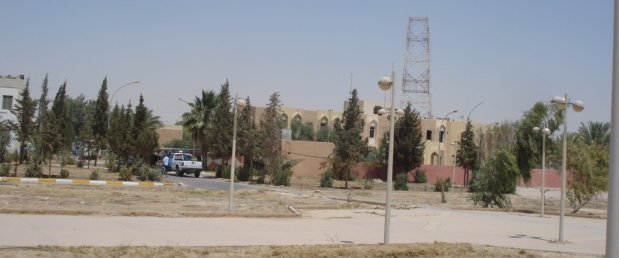
The mayor told us that Anah is a 5000 year old city built in 1985. The site of ancient Anah now lies under the waters of Lake Qadisiya. When the Hadithah Dam was built, the Iraqi government hired a French firm to design a new city on higher ground. The result was a pleasant new city, with wide streets organized on Cartesian grid, which can be appreciated even through the detritus of war. The first building was the mosque and the rest of the city was built around it.
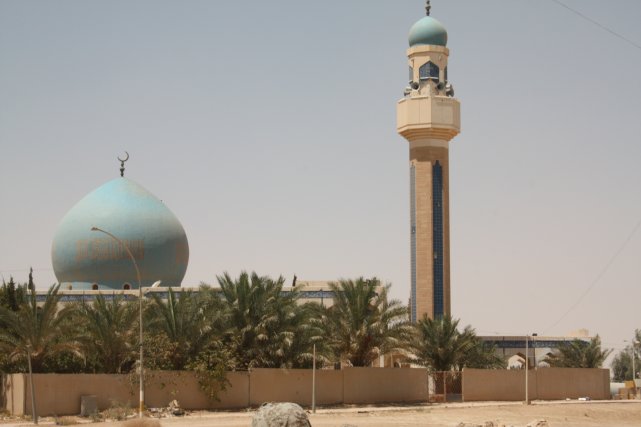
I was surprised to learn that the mayor did not have an accurate estimate of his city’s population. He said that people were beginning to return and that the population was growing. Anah has long been known for its educated and effective workforce. These are the people who suffered most from the recent insurgency. The insurgents specifically targeted the best educated members of the population, who they considered corrupted, westernized not sufficiently pious, or all of the above. As a result, many of the best and brightest are either dead or living outside the region or the country. Making matters worse, during the 1990s, the city declined as a result of the general poor conditions in Iraq. Anah’s education level meant that many of its people COULD leave and sell their skills elsewhere, so the city declined even more precipitously than some others with less mobile workforces.
The mayor doesn’t think the sojourning population will return anytime soon. They have built successful lives someplace else and Iraq will offer them no corresponding opportunities in the near term. In the longer term, however, he expects some return of the diaspora. When people have made their fortunes, he hopes they will return to the pleasant city on the shores of Lake Qadisiya.
The mayor was optimistic about the future. In five years’ time, he expects Anah to have prosperity levels similar to Amman, Jordan. Amman is not to the level of a developed world’s city, but it is significantly better off than Anah. Anah has a long way to go, but considering how far it has come in the last couple of years, a smaller version of Amman may not be an impossible dream.
Electrical Power
Alone among all the cities of all of Western Anbar and probably in all of Iraq, the little city of Anah does not have a significant problem with electricity shortages, at least according to what the mayor told us. How is this possible?
The picture below shows Hadithah Dam, which supplies much of Anbar’s power and created the reservoir that drown old Anah. Anah gets its power from the dam and from petroleum fueled generators.
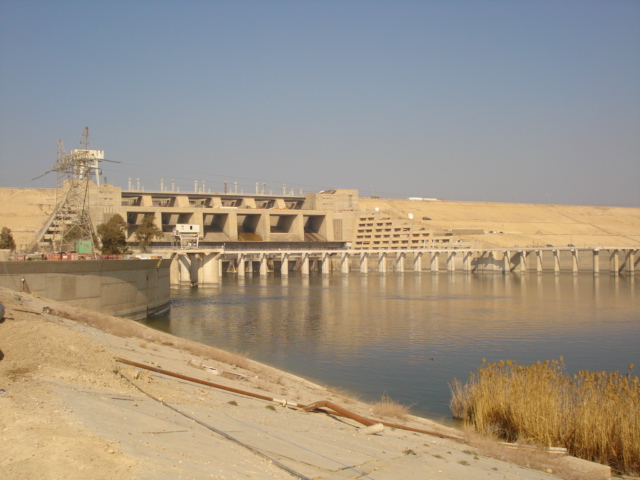
Anah spells relief from energy shortages m-e-t-e-r-i-n-g. Anah is evidently the only city w/o a significant energy problem because it is one of the few to meter effectively and charge for electricity. Most other places electricity from the grid is essentially free, or at least not properly metered. People have no incentive to use it wisely. In fact, those who limit their own use of power are just chumps, as somebody else will eagerly soak up the surplus they create. Our visits around the province have found profligate use of electrical power, when it is online, followed by bitter complains when it goes down. We have also noticed stores full of electrical devices ranging from small appliances to big screen television sets just waiting to absorb any new power that is generated. Anbar clearly has an electricity problem. Just as clearly, it cannot find a solution by increasing supply alone. Electricity currently is de-facto distributed by political fiat. Local leaders demand, persuade, cajole and perhaps do other less savory things to get a bigger share of insufficient resource. Demand for any free product grows as rapidly as supply can keep up or, as in the case of Western Anbar, even faster. It will be great to build more capacity and Iraq has the money to do that and this new capacity will satisfy demand only when the rest of the country behaves more like Anah.
Pushing Back the Desert
In any climate as dry as Western Iraq’s, water management is the key to success and even survival. The Euphrates River is especially low this year from a combination of drought and increased diversions upstream in Syria and Turkey. As you drive across the river, you can see that the bridge was built to span a much wider flow. In some cases, the water is hundreds of yards from the evident previous banks and new islands have emerged in the middle, a profuse cover of vegetation and the presence of goat grazing it indicating that this may be more than an ephemeral anomaly.
Low river levels create challenges for irrigation. In many cases, pipes that once easily drew the water emerge onto dry land. Authorities are digging wells and extending pipes as “temporary” expedients, but everyone understands that even when the rains return, upstream dams and diversions have permanently altered the shape and hydrology of the river. The future of the Euphrates may be something like the Colorado.
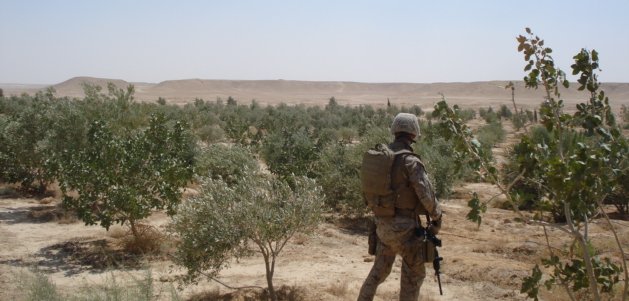
But the people of Anah are not content to let the desert will expand. We visited a project to plant trees to hold the soils and create a more benign microclimates. Above and below are pictures of a one-year old installation and another nearby that has been growing for eight years. Our ePRT is helping these projects in a small way with advice and funds, but we cannot take credit for initiating them. The oldest trees in this particular plantation are eight years old. They include date palms, pistachios and olives. The local arborists take seeds and cuttings from the most robust individuals and use them for nursery stock to expand the effort.

The trees are currently sustained with a drip irrigation system, but once established they can usually get along on the stingy local rainfall, according to the Chief of Agricultural Engineers for the desertification reversal project. This, BTW, is exactly what Dennis Neffendorf told me and the engineer and I had a good conversation about soils. In many ways, the dust bowl we experienced on our own Great Plains is analogous to the current situation in Iraq. Iraq is dryer, but as with our own case the destruction of perennial vegetation cover exacerbated a bad situation and damaged a fragile ecosystem.
The picture below shows seedlings growing in a lattice house, which protects them from the burning sun.
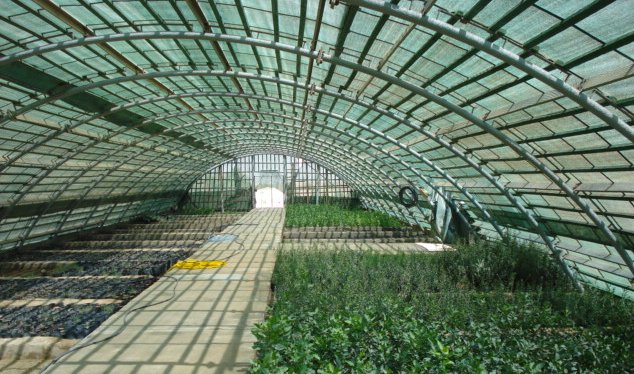
We talked a little about goats, those pernicious desert making machines. The engineer showed us perennial leafy plants (I didn’t recognize it but it sort of resembled heather) that not only can survive moderate browsing by goats, but actually require it for sustained growth. His nursery has been propagating these plants and is hoping to cover some of the dusty expanses of the country with this green food. Some of these plants are non-native and I did pause to recall that kudzu, crown vetch and multiflora rose were once touted by our own government experts as solutions to problems, but looking up at the desiccated dusty desolation that lies outside any man-made green zone, I think that anything is an improvement.
Potatoes, Cows & Fish
The Anah region grows substantial amounts of potatoes. This surprised me, since potatoes are water intensive and grow best in a loose, sandy soil very different from the hard clays and hard pan we see in Anbar. When they explained it to me, it still seemed like it was more trouble than it was worth, but they disagreed. The soil is indeed not suited to potato cultivation, so they change it by bringing richer, sandier soils up from the river bed. I took a handful of it and it looked and felt like those Wisconsin or Polish soils I had seen growing rich potato crops. Of course, they also bring the water up from the river. The potato farm supervisor, told me that yields vary greatly, but that they could get 3-8 tons of potatoes from an acre.
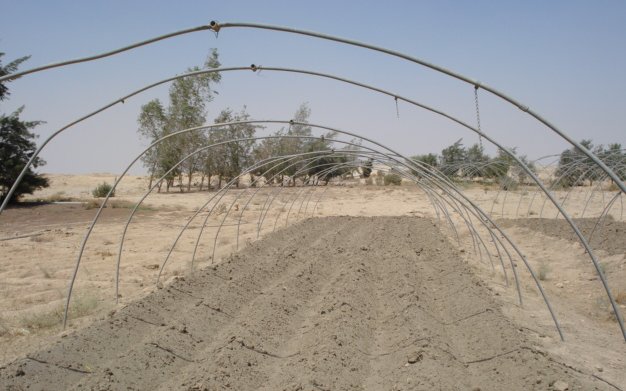
I doubt that he understood my point of reference and may have been talking about an Iraqi donum, which is 0.67 acre, or he may have thought I meant hectare. It gets worse, because an Iraqi donum is much bigger than a Turkish donum … Suffice it to say, it makes a difference. And did he think I meant short ton, long ton or metric? Unfortunately, I didn’t think of this until after I was headed back to Al Asad. I just assumed. Mea culpa, I should know better. I was reminded how hard it is communicate not only in a different language but also in a different measurement culture. Three to eight tons an acre is a very high yield and if indeed we are talking the same measurements, I guess it makes sense to grow potatoes in the desert. But I realize that I have a meaningless data point in my notebook and must remember not to do that again. It doesn’t matter, since we are not doing a precise survey. All I need to know is that the Iraqis seemed satisfied with whatever yield they are getting from whatever area they are talking about and they don’t think it is a problem.
Their problems include the need for a shade tarp and the threat of aggressive goats. Full sunlight is not a friend around here most of the year. Growers put up shade tarps to protect garden crops during the heat of the day. Our Iraqi friends mentioned that their shade tarp supports were damaged. Something else they need is a fence to protect them from marauding goats. This latter requirement may be less effective than it seems, since the marauding goats’ owners will open it up. In any case, they asked us to help with a grant. We will consider it, but are disinclined at this point, since it is something the Iraqi authorities can provide.
We also visited the site of a future dairy farm/creamery complex. When completed, the facility will produce milk, cheese, yogurt and – after a suitable interval – hamburger. Initially they will get 250 head of dairy cattle and expand as demand conditions allow. They are currently waiting on a “green zone”, irrigated fields that will provide the fodder crop to feed the cattle. This will be done with pivot style irrigation making those crop circles so prominent in arid places in our country. They wisely want to get the feed production up and running before the cows come home. This is not as clear a decision as it seems to most of us. Planners often fail to put things in logical order and discover only afterwards that they missed a key step. The Anah authorities have thought through all parts of the lifecycle, including proper use of manure. The agricultural engineer also told me that they have plans to apply municipal biosolids to the pastures.
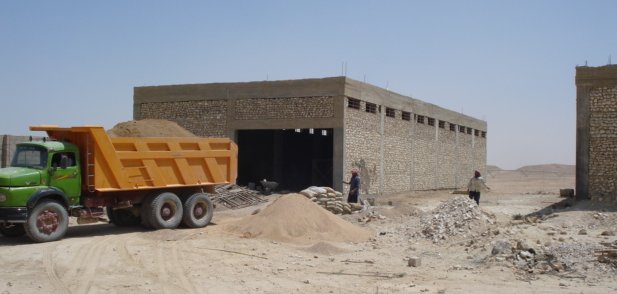
The dairy farm didn’t look like anything I remember in Wisconsin. There will be no quaint red barns (the pictures nearby shows what the barn and milking stalls will look like) and there will never be verdant hill dotted with spotted cows. This is much more like an industrial agricultural enterprise. The only thing that caused me some concern was the source of management and money. It is a state sponsored operation. I don’t have confidence that a state run enterprise can work better in agriculture than it does anywhere else, but at this time there are no other investors willing or able to take on this sort of challenge.
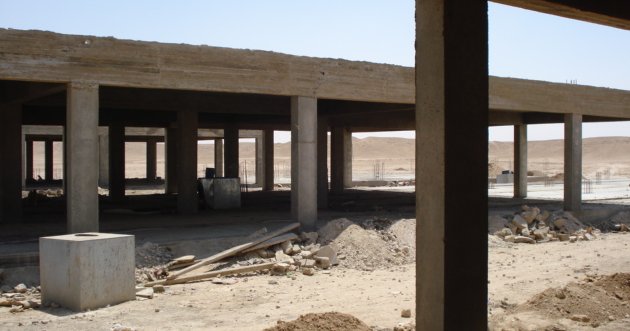
We were scheduled to visit the fish hatchers and poultry farm, but ran out of time. Briefly speaking, the fish hatchery is meant to supply stock for local fish farms and restocking of Lake Qadisiya. Anah authorities are interested in getting QRF money to help repair and restore the hatchery. This is probably something that will be left to the Iraqi authorities.
Our short trip to Anah revealed a well organized and well managed town with more strengths than weaknesses; more opportunities than threats. There is reason to be optimistic.
